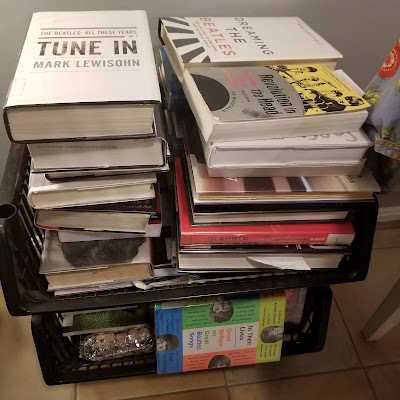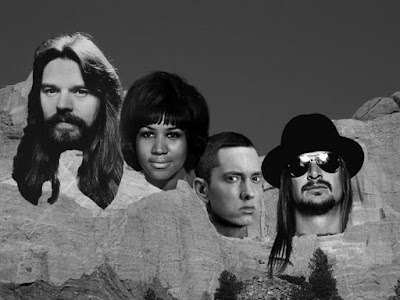Believe me when I tell you
I'll never do you no harm
This summer, I plan to read all the books by the late author Larry McMurtry that I didn’t manage to read while he was still alive – as well as re-read some of his books that I have previously read.
In addition, I’m going to do a lot of reading about the Beatles. Photos of a number of the books about the Beatles that I’ve checked out from my local library appear above.
Put them all together and you have quite a pile:
* * * * *
The classic Broadway musical, The Sound of Music, includes a song sung by a group of nuns who don’t know what to make of an unconventional young postulant named Maria:
How do you solve a problem like Maria?
How do you catch a cloud and pin it down?
I feel somewhat the same way about the Beatles as those nuns felt about Maria.
It’s an article of faith among baby boomers that the Beatles were the greatest band of all time, and that belief is shared by many younger people who weren’t even born when the Beatles bestrode the sixties like the Colossus of Rhodes supposedly bestrode the entrance to that city’s harbor:
But figuring out just what it was about the Beatles that made them so special is akin to catching a cloud and pinning it down.
* * * * *
It defies reason that three seemingly unremarkable teenagers from an unremarkable neighborhood in a nondescript English city would become such a phenomenon. (No disrespect to Ringo, but he was not a songwriter like the other three Beatles, who had become a well-established unit before Ringo appeared on the scene.)
If the Beatles aren’t the most convincing proof ever that a whole can be greater than the sum of its parts, I don’t know what is. (Let’s face it: the Beatles’ work as solo artists pales in comparison to their oeuvre as a group.)
* * * * *
Earlier this year, I wrote a series of posts that analyzed the structure and lyrics of a dozen or so Beatles records that were released in 1963 or 1964.
I pointed out that the typical Lennon-McCartney song from that era consisted of only about a minute’s worth of original material. These “songlets” were stretched to an acceptable length through shameless repetition. For example, “Love Me Do” – one of twenty #1 hit singles released by the Beatles – had only one verse (which was repeated with almost no variation four times) and an eleven-word bridge (which was repeated twice).
I expected the Beatles worshippers among my readers to react badly to what I knew they would view as criticism of their musical demigods.
But describing my writing as as “anti-Fab Four diatribe,” “an unrelenting smear job,” and an “endless vendetta” seemed a little over the top,
Don’t have a cow, man!
* * * * *
One of my critics described my posts thusly:
You dissect (those songs) like a high-school biology teacher with a frog, and are disgusted by the innards.
I plead guilty to the charge that I took those songs apart and analyzed them like a scientist might dissect and examine a specimen.
And I admit that I find some of them a bit meh . . . but feeling meh about a record is a far cry from feeling the way most of us would feel if we were confronted by a heapin’ helpin’ of frog innards.
It’s more than a little hyperbolic to say that I’m “disgusted” by the Beatles records I wrote about in those posts. Just because you fail to fall on your knees to worship something doesn’t indicate that you’re disgusted by it.
* * * * *
Maybe all the reading I plan to do over the next few months will enable me to figure out what made the Beatles so special.
That assumes, of course, that the Beatles actually were that special. Everyone I know thinks they were, and they’re probably right – but I’m going to try to keep an open mind until I’ve completed my research and taken some time to mull things over.
I’ll report back to you sometime this fall. (I see you shiver with antici- . . . -pation!)
* * * * *
Today’s featured song does nothing for me except give me a headache. (I doubt that the Beatles were trying to make a fingernails-on-a-chalkboard record when they recorded “Oh! Darling,” but they certainly succeeded in doing exactly that.)
“Oh! Darling” was written by Paul McCartney, and he handled lead vocal duties when the song was recorded.
It was released on Abbey Road in 1969. It was never issued as a single in the U.S. or UK – the Beatles weren’t stupid – but was released as a single in Central America, Portugal, and Japan. (No, I don’t know whether it was a hit in any of those places.)
John Lennon had this to say about the song in a 1980 interview:
“Oh! Darling” was a great one of Paul’s that he didn’t sing too well. I always thought I could have done it better – it was more my style than his. He wrote it, so what the hell, he’s going to sing it.
Lennon very well might have done a better job with “Oh! Darling.” But that’s only because the record is so bad that John probably couldn’t have made it worse if he had tried.
Based on this song, you might conclude that Paul McCartney didn’t learn a thing about songwriting between 1963 and 1969. For one thing, the lyrics are utterly generic. In addition, “Oh! Darling” is a classic Beatles “songlet”: it consists of only two short verses and a bridge, each of which is repeated mechanically in order to stretch the song from 1:40 to a more respectable length.
Sources differ as to whether John or Paul played the piano on “Oh! Darling.” (If I was McCartney, I’d blame it on Lennon – he’s dead, so he couldn’t sue Paul for defamation.)
Click here to listen to “Oh! Darling.” But before you do, I’d recommend that you get a jump on the headache that is guaranteed to follow by knocking back a couple of aspirin first.
(I’m not going to bother to include a link so you can buy the song from Amazon – I have too much respect for you to do that.)


























